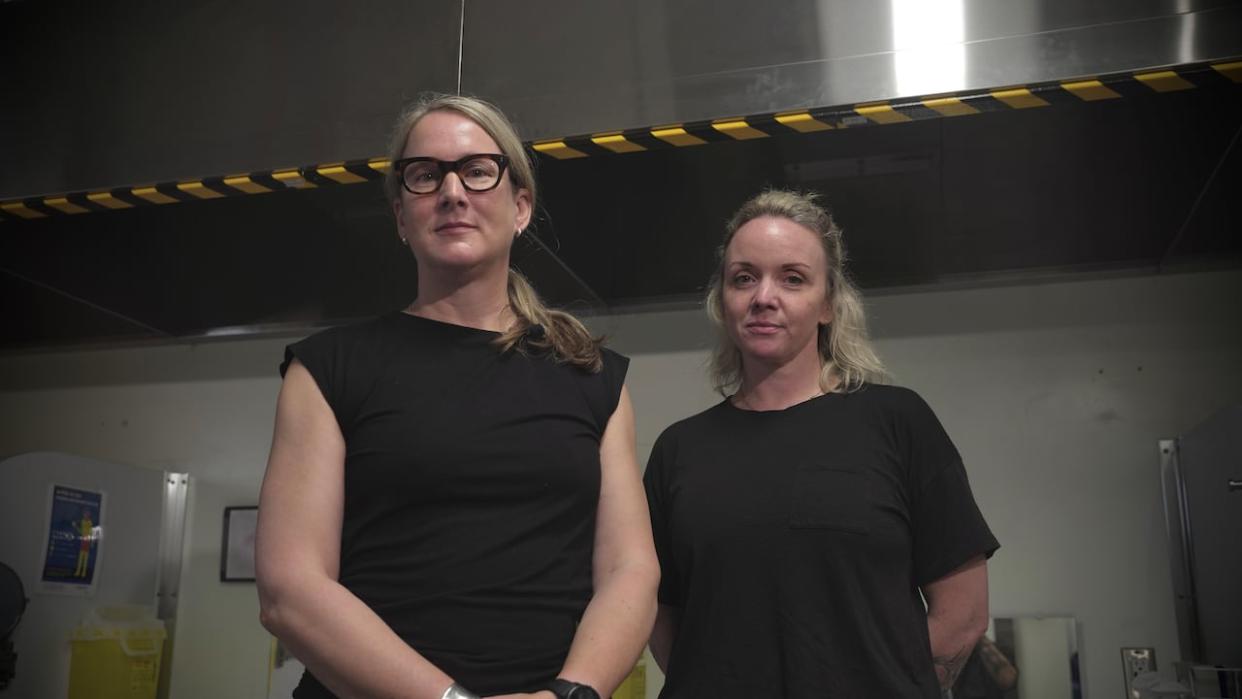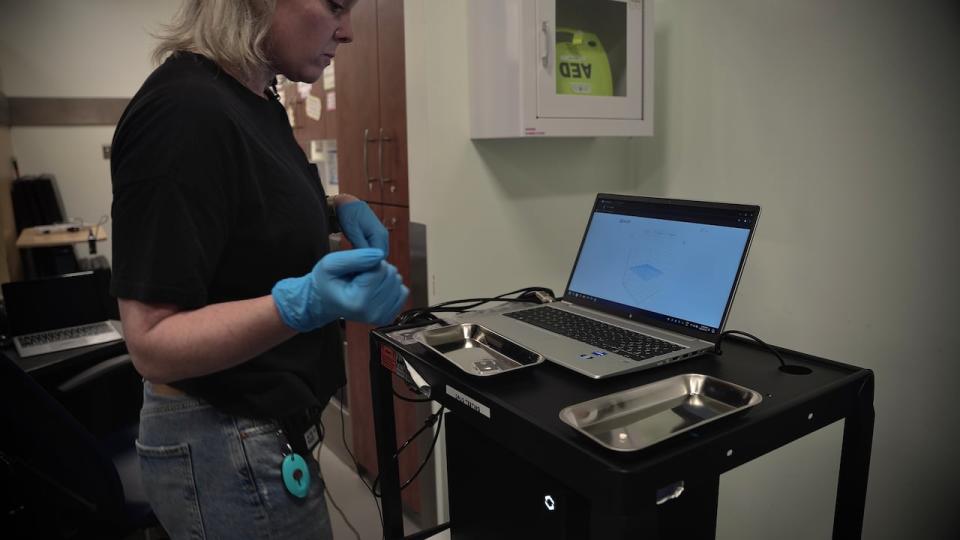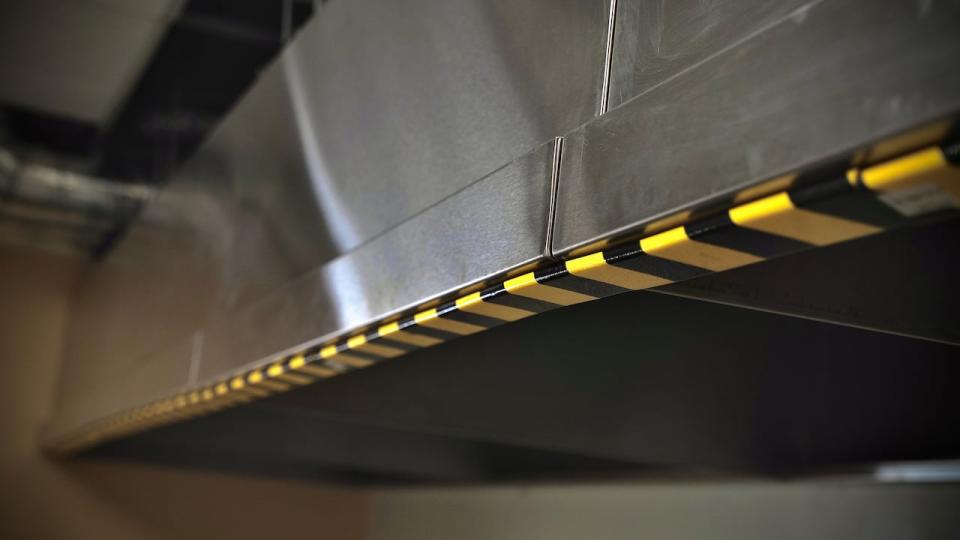Powerful vents will suck out drug fumes when Sandy Hill consumption site reopens next week

Taylor McMullin remembers when the "weird headaches" began.
It was February, and she was working at the supervised consumption site at Sandy Hill Community Health Centre. She and her colleagues were working in a tiny space as a steady steam of drug users heated their substances, often to prepare them for injection.
"At one point I was sick to my stomach and I had to go home," she said.
The symptoms were unusual, and she wasn't the only one to feel ill.
"The next thing you know, there's six of us saying, 'Why do we all have headaches? That's weird. It's getting better when I leave the site,'" said McMullin. "Then we kind of found out it was probably to do with the drug supply."

A view of the new hoods hanging over the booths where clients prepare and use drugs under supervision at Sandy Hill Community Health Centre's OASIS program. (Nick Persaud/CBC)
Wendy Stewart, director of Sandy Hill's OASIS program, said there was "a distinct smell" like tar or burning tires.
"You could even smell it on people's clothes," she said. "Staff that were exposed to that immediately felt headaches, nausea, dizziness."
It's been more than four months since those symptoms forced the Sandy Hill and Somerset West community health centres to close their consumption sites. Somerset West has since reopened, and Sandy Hill is just wrapping up renovations.
It has cost $80,000 to add a new ventilation system that turns the consumption site into what Stewart compares to a chemistry lab or a hospital isolation room. It sucks out fumes and rapidly recycles air to keep staff safe from an increasingly toxic drug supply.
Stewart is planning to reopen on July 15. She said closing was a tough decision that's left some at the centre dealing with guilt.
"It's been very stressful for our staff," she said. "There's been moral distress that people are outside having to use instead of within a safe space."
More clients using more toxic drugs
Investigations never pinpointed exactly what substance was responsible for the wave of sickness that hit staff, according to Stewart.
But she has some ideas. One is the steep rise in the volume of patients over the past five years.
In 2019, when the centre opened, it saw about 1,600 visits. In the 10 months before it closed in February, there were more than 10 times that number, close to 18,000 visits.

Gunn uses a drug testing machine. The centre has noted that drugs are more often adulterated with other substances such as fentanyl mixed with benzodiazepines, or even stronger opioids with the street name 'pyro.' (Nick Persaud/CBC)
The centre has also noticed a troubling shift in what those visitors are cooking. When staff put samples into their laser-based drug testing machine, they're finding all sorts of substances that were "never meant to be combustible."
"What we would have seen years ago was mostly clean drugs, and now we are seeing that every day's a different day," Stewart said.
"Staff are in here 12 hours a day, and constant cooking, vaping of these substances was rendered hazardous given the fact that we had inadequate ventilation."
Previously, the centre's ventilation system consisted of three simple ceiling vents of the sort common in a typical office. After those weird symptoms began cropping up, a company called Environmental Consulting Occupational Health confirmed that the system wasn't up to the task.
'The air is scrubbed'
The new system most definitely is up to the task, according to Stewart. She said it turns the consumption site into a "negative pressure room."
The site has five booths for clients to prepare and use their drugs. Now, each one is topped by a vent surrounded by a large rectangular hood. Stewart said the system is strong enough to draw contaminants away from staff members who work just a few metres away.
"Each booth has its own air exchange system so that whatever is being cooked, or whatever off-gassing or vapours are occurring through the process of cooking their drugs, is pulled directly up into this hood and away from staff," she said. "The air is scrubbed and pulled outside."

A closeup of the vent hoods over the booths at the supervised consumption site at the Sandy Hill Community Health Centre's OASIS program. (Nick Persaud/CBC)
Typically, the system recycles all the air in the room 3.7 times every hour. But if sensors detect elevated levels of contaminants, it automatically steps up to a pace of 26 times per hour.
According to Stewart, the consumption site is a vital harm reduction tool that keeps opioid users alive. Of the nearly 18,000 visits to the supervised consumption site, clients have had to go to the emergency room just 12 times.
In a statement, Ottawa Public Health (OPH) said Sandy Hill's reopening means that Ottawa will again have four supervised consumption sites.
Kira Mandryk, OPH's program manager of sexual health and harm reduction services, said the sites prevent overdoses, overdose deaths and risk factors related to infectious diseases, while also connecting people to needed services.
McMullin said she's eager to welcome clients back to the Sandy Hill site. She trusts that the new vents will be enough to do so safely.
"I'm really confident that we've got a good plan to make sure that it's actually safe for us, and that they've taken a lot of steps. It looks very different in here. We look like a very fancy kitchen," she said.
"I think they've taken the process seriously and I'm really excited to see us reopen. I know our clients are very anxious for us to reopen."


